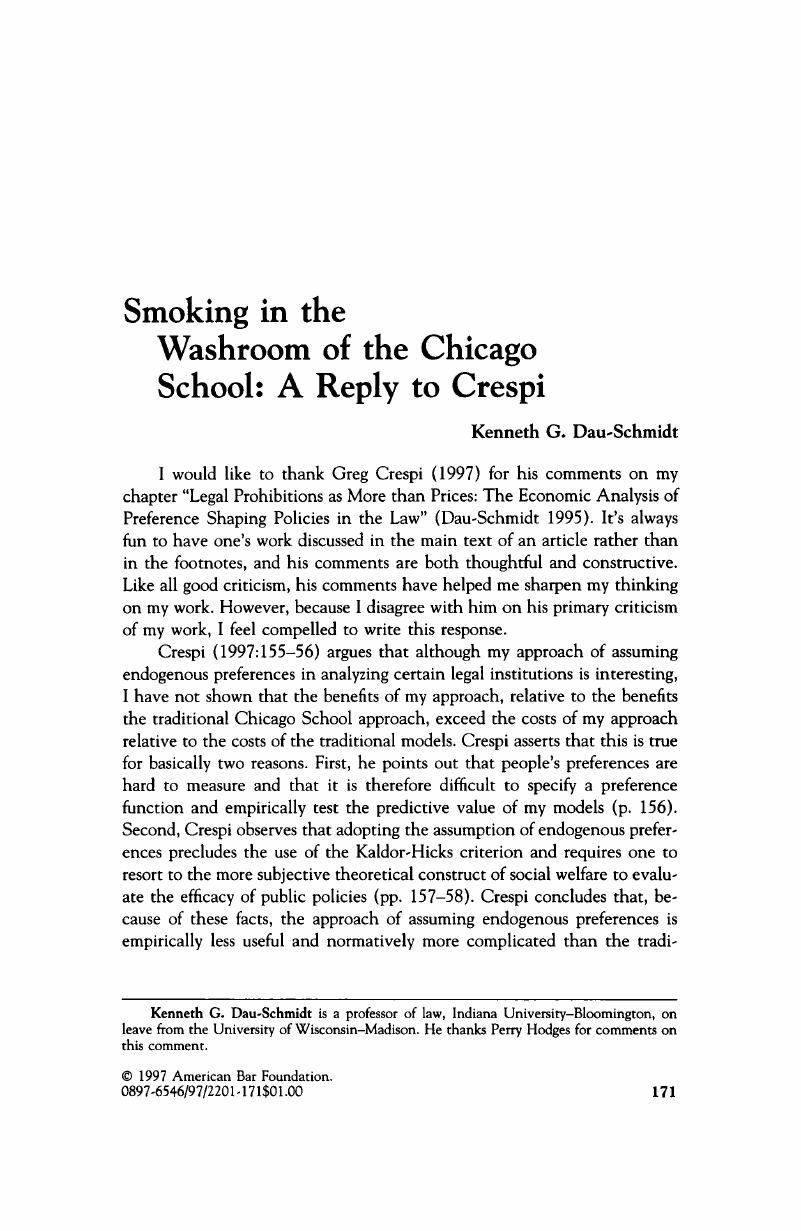No CrossRef data available.
Article contents
Smoking in the Washroom of the Chicago School: A Reply to Crespi
Published online by Cambridge University Press: 27 December 2018
Abstract
An abstract is not available for this content so a preview has been provided. Please use the Get access link above for information on how to access this content.

- Type
- Review Essay
- Information
- Copyright
- Copyright © American Bar Foundation, 1997
References
Baumol, William J.
1986. Superfaimess, Application and Theory. Cambridge, Mass.: M.I.T. Press.Google Scholar
Becker, Gary S.
1968. Crime and Punishment: An Economic Approach. Journal of Political Economy
76:169–217.Google Scholar
Chaing, Alpha
1984. Fundamental Methods of Mathematical Economics. 3d ed. New York: McGraw-Hill Book Co.Google Scholar
Coleman, Jules L.
1982. The Economic Analysis of Law. In NOMOS XXIV: Ethics, Economics, and the Law, edited by Roland Pennock, J. and Chapman, John W.
New York: New York University Press.Google Scholar
Coleman, Jules. 1985. Crime, Kickers, and Transaction Structures. In Nomos XXVII: Criminal Justice, edited by Roland Pennock, J., & Chapman, John W.
New York: New York University Press.Google Scholar
Crespi, Gregory. 1991. The Mid-Life Crisis of the Law and Economics Movement: Confronting the Problems of Nonfalsifiability and Normative Bias. Notre Dame Law Review
67:231–52.Google Scholar
Crespi, Gregory S.
1997. Does the Chicago School Need to Expand Its Curriculum
Law and Social Inquiry
21:149–69.Google Scholar
Dau-Schmidt, Kenneth. 1990. An Economic Analysis of the Criminal Law as a Preference-Shaping Policy. Duke Law Journal
1990:1–38.Google Scholar
Dau-Schmidt, Kenneth G.
1991. Relaxing Traditional Economic Assumptions and Values: Toward a New Multidisciplinary Discourse on Law. Syracuse Law Review
42:181–95.Google Scholar
Dau-Schmidt, Kenneth G.
1995. Legal Prohibitions as More than Prices: The Economic Analysis of Preference Shaping Policies in the Law. In Law and Economics: New and Critical Perspectives, edited by Malloy, Robin P. and Braun, Christopher K. 1995. New York: Peter Lang Publishers.Google Scholar
Ehrlich, Isaac. 1975. The Deterrent Effect of Capital Punishment: A Question of Life and Death. American Economic Review
65:397–417.Google Scholar
Ferguson, C. E., and Gould, J. P.
1975. Microeconomics Theory. Homewood, Ill.: Richard B. Irwin, Inc.Google Scholar
Friedman, Milton. 1953. The Methodology of Positive Economics. In Essays on Positive Economics, edited by Friedman, Milton. Chicago: University of Chicago Press.Google Scholar
Gibband, Allen, and Varian, Hal. 1978. Economic Models. Journal of Philosophy
10:664–77.Google Scholar
Hart, H. L. A.
1967. Social Solidarity and the Enforcement of Morality. University of Chicago Law Review
35:1–13.Google Scholar
Klevorick, Alvin. 1985. On the Economic Theory of Crime. In Nomos XXVII: Criminal Justice, edited by Pennock, J., & Chapman, J.
New York: New York University Press.Google Scholar
McManus, M.
1978. Social Welfare Optimization with Tastes as Variables. 114
Welttwrt-schaftUches Archive
114:101–22.Google Scholar
Parker, Jeffrey S.
1993. The Economics of Mens Rea. 79
Virginia Law Review
79:741–811.Google Scholar
Posner, Richard. 1980. Optimal Sentences for the White Collar Criminals. American Criminal Law Review
17:409–18.Google Scholar
Posner, Richard. 1985. An Economic Theory of the Criminal Law. Columbia Law Review
85:1193–1231.Google Scholar
Varian, Hal. 1975. Distributive Justice, Welfare Economics, and the Theory of Fairness. Phibsophy and Public Affairs
4:223–47.Google Scholar
Varian, Hal. 1987. Intermediate Microeconomics: A Modem Approach. New York: W. W. Norton & Co.Google Scholar
Veljanovski, Cento. 1980. The Economic Approach to Law: A Critical Introduction. British Journal of Law and Society
7:158–93.Google Scholar




